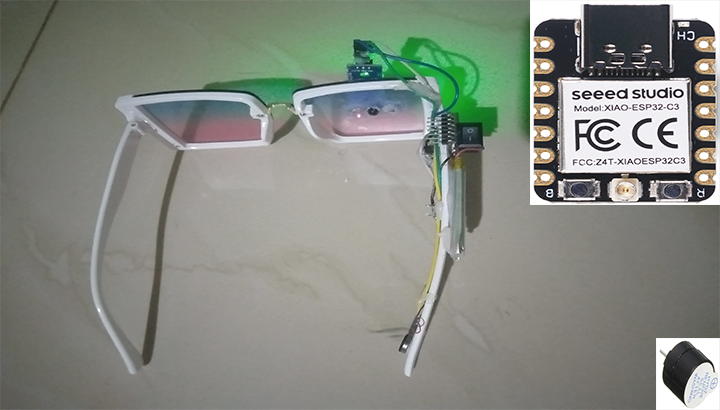ANTI-SLEEP SYSTEM FOR VEHICLE DRIVER BASED ON SEEED STUDIO XIAO ESP32C3

This research venture seeks to make a significant contribution to road safety efforts by providing an efficient solution for the identification and prevention of drowsy driving occurrences, thereby lowering associated risks and improving the well-being of drivers and other road users. A thorough understanding of drowsy driving is provided by the combination of sensor data, interviews, and questionnaires, which serves as a foundation for the development of the anti-sleep system.
Working principle of the block diagram or circuit diagram
The working of this project is based on an Infra-Red Sensor, this sensor is the heart of this project.
The picture of Circuit diagram shows a typical IR Sensor, basically it has a transmitter IR LED, A photo Diode, an Op-amplifier IC and a potentiometer. The photo diode is placed just next to the IR LED in such a way that it cannot receive IR rays directly. Photodiode is sensitive to the IR radiation. Its cathode connected to the positive voltage i.e. 5volt and anode connected to the noninverting input of the Op-amplifier which also get pulled down though the 4.7Kilo ohm resistor. Potentiometer in IR sensor is use to set the sensitivity distance of the sensor, it connected to the inverting input of the Op-amplifier. IR LED continuously transmit the infra-red rays and if any object comes in front of it, IR rays get reflected back and it received by the photo diode due to this change in IR radiation the voltage at the anode get change, the change in anode voltage is depend on the IR radiation received by the photo diode. More the IR radiation received grater will be the change in anode voltage. The output of the IR Sensor taken from the output of the Op-amplifier.
We can adjust the sensitivity distance by rotating the potentiometer on the sensor, we rotate the potentiometer that means we set a threshold voltage for the noninverting input of the Op-amplifier. Whenever the voltage on the noninverting input is greater than the threshold voltage, the voltage on the noninverting input i.e. +ve voltage from the photodiode get forwarded and get the positive pulse at the output of the Op-amplifier i.e. output of the sensor.
IR sensor is connected to the Seed studio XIAO ESP32C3 Pro Mini board as Vcc of the sensor to the vcc of the Seed studio XIAO ESP32C3 Pro Mini, Ground to the ground and the output of the sensor to the Analog pin one D3 of the Seed studio XIAO ESP32C3 Pro Mini. I used a 5volt buzzer and a vibrator motor for alerting. I connected both buzzer and vibrator motor in parallel and used a general purpose NPN Transistor (BC547) to drive them. Transistor's emitter connected to the ground and collector connected to the negative pin of the buzzer and vibrator motor. Positive terminal of vibrator motor and buzzer are further connected to the vcc of the Seed studio XIAO ESP32C3 Pro Mini. Base of the transistor connected to the pin D9 of the Seed studio XIAO ESP32C3 Pro Mini through the 4.7 kilo ohm resistor.
Related project idea for free
Conveyor Belt Control System with ESP8266 and Servo Motor for Item Sorting
The Conveyor Belt Control System with ESP8266 and Servo Motor is an advanced project designed to automate the control, monitoring, and sorting of items on a conveyor belt. This system uses the ESP8266 Wi-Fi module for wireless communication, enabling remote management and real-time monitoring of con...
Read more>>Arduino-Powered Proximity Sensing Radar
This project aims to develop a simple radar system using Arduino, incorporating a variety of electronic components including an ultrasonic sensor, buzzer, LED, LCD display, and a servo motor. The primary objective is to detect objects within a defined range and provide visual and auditory alerts. <...
Read more>>Smart Cradle System Project - IOT-Based project
The Smart Cradle System is designed to enhance the care and monitoring of infants through automation and real-time monitoring. This system integrates various sensors and microcontroller-based circuitry to provide a safe and comfortable environment for the baby. It includes features such as automated...
Read more>>IoT Based Health Care System for Paralysis Patients
The IoT-based health care system for paralysis patients is designed to enable patients to communicate various messages to doctors, nurses, or their loved ones remotely over the internet. This system utilizes a microcontroller-based circuitry to facilitate its functionality. It incorporates a hand mo...
Read more>>IOT Project for Greenhouse Monitoring and Control System
A greenhouse is an environment where plants, such as flowers and vegetables, are cultivated. It utilizes solar radiation to warm the interior, including the plants, soil, and structure, thereby protecting crops from various diseases, particularly soil-borne pathogens and those spread by rain splash....
Read more>>




